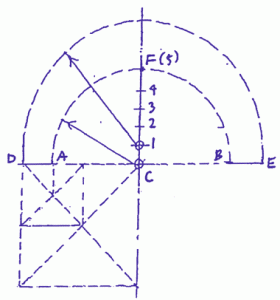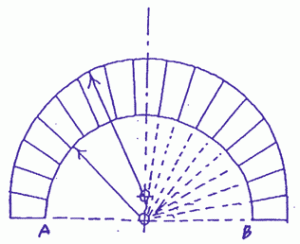To construct a Florentine Arch
 The Renaissance master-architects developed the form of the Florentine Arch in their search for a unique expression of their time. It remains one of the subtlest arch configurations of all time. The Florentine Arches of the Palazzo Riccardi ( Medici) and the Palazzo Strozzi attest to this ageless beauty. The construction shown here is relatively straight-forward but it’s simplicity is not readily apparent to an observer.
The Renaissance master-architects developed the form of the Florentine Arch in their search for a unique expression of their time. It remains one of the subtlest arch configurations of all time. The Florentine Arches of the Palazzo Riccardi ( Medici) and the Palazzo Strozzi attest to this ageless beauty. The construction shown here is relatively straight-forward but it’s simplicity is not readily apparent to an observer.
- Given the span AB.
- Bisect the span AB to locate point C.
- Produce the line CA a difference equal to one-third CA to locate point D. Do the same for line CB to locate point E.
- With point C as centre, radius CA, draw a semi-circle.
- Where the bisector of line AB, produced, meets the semi-circle, locate point F.
- Divide the distance CF into 5 equal parts and starting a C as O number the divisions 1,2,3,4, and 5 (F).
- Construct a perpendicular from points D and E respectively.
- Using division point 1 as a centre, draw a semi-circle to meet the perpendicular line produced from points D and E.
- Using point C as a centre, draw the radiating lines of voussoirs of the arch. Be careful to make the central voussoir or keystone centered on the bisector line CF. The example shows 17 voussoirs (There will always be an added number of voussoir in an arch).
 Architects, architectural historians, masons, carpenters, wood-workers and cabinet-makers will find this construction very useful. And as an added bonus it can be easily developed with the most basic of instruments and/or tools.
Architects, architectural historians, masons, carpenters, wood-workers and cabinet-makers will find this construction very useful. And as an added bonus it can be easily developed with the most basic of instruments and/or tools.